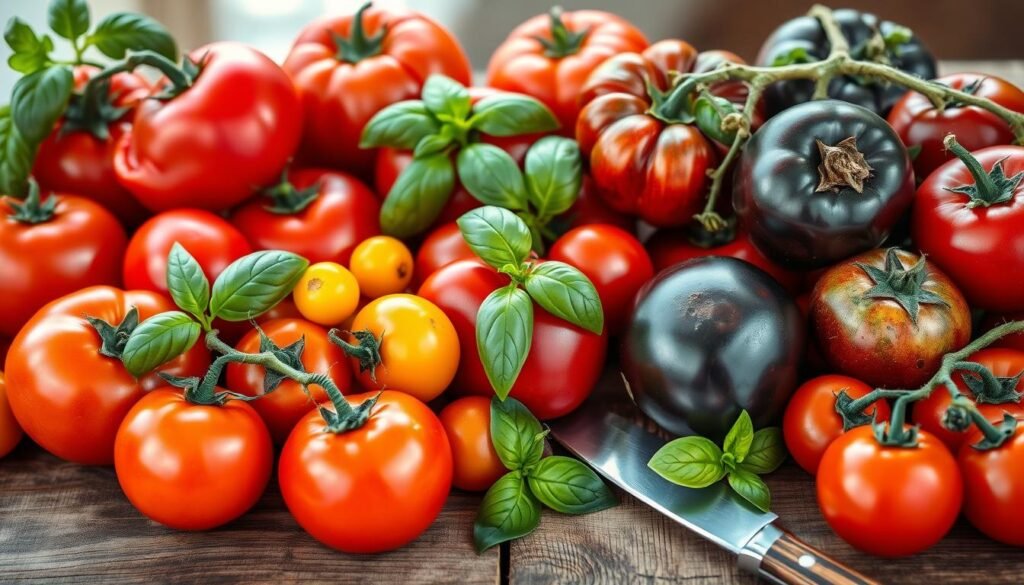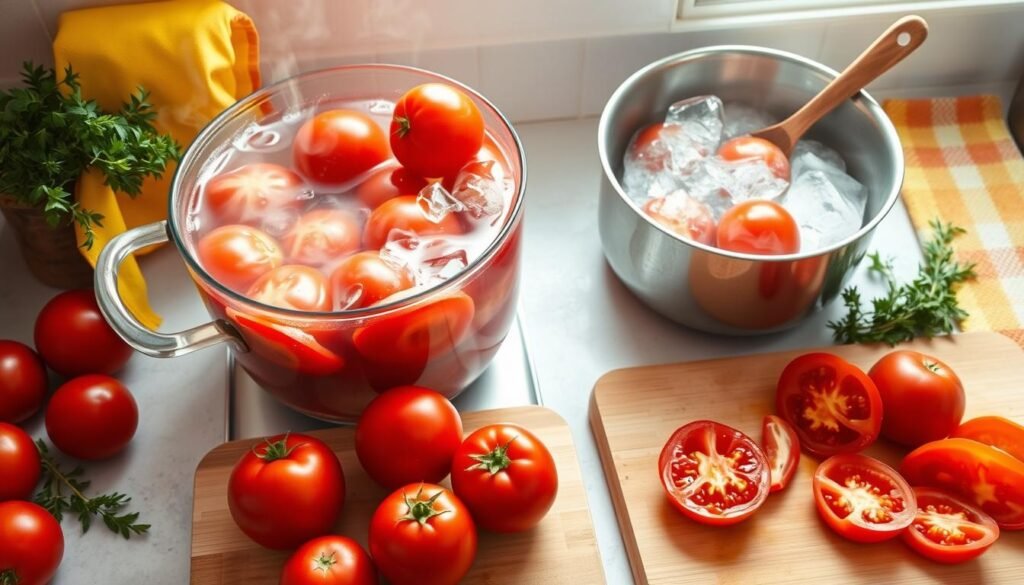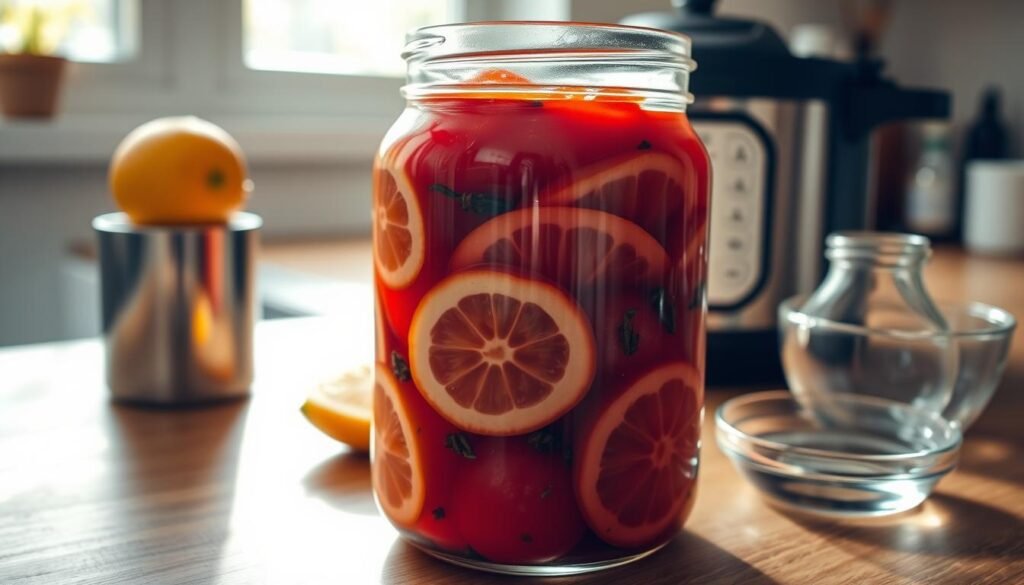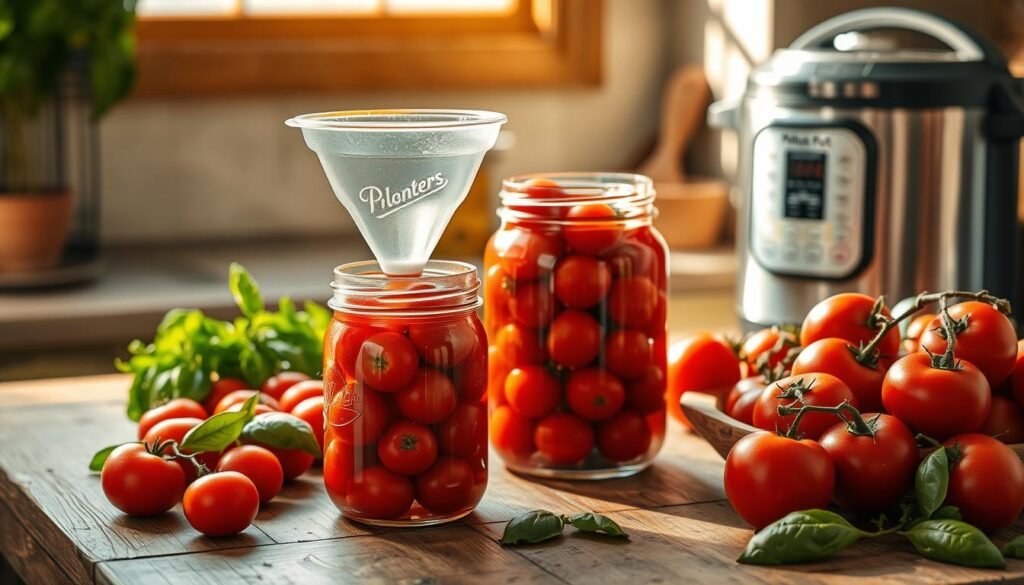Did you know a single tomato plant can yield up to 20 pounds of juicy tomatoes1? Canning these tomatoes is a great way to keep summer’s taste alive all year. This guide will show you how to can tomatoes using a pressure cooker. You’ll learn how to prepare ingredients and safely store them for a long time.
Canning tomatoes at home has many benefits. It saves space and is handy for emergencies1. Plus, home-canned tomatoes are often juicier and can be seasoned to your liking1. But, it’s important to keep acidity levels right and follow safe canning methods to ensure your tomatoes are safe and tasty.
Key Takeaways
- Canning tomatoes at home provides a convenient and space-saving way to store fresh produce for year-round use.
- Proper acidification and high processing temperatures are essential for safe home canning of tomatoes.
- The pressure canning method is recommended for canning tomatoes to ensure they are processed at the necessary temperature.
- Choosing the right type of tomatoes and following step-by-step instructions are critical for successful home canning.
- Canning tomatoes allows you to enjoy the flavor of summer all year round and prepare for food emergencies.
Introduction to Canning Tomatoes
Canning your own tomatoes at home has many benefits. You get to choose the ingredients, ensuring they are fresh and free from additives. Homemade canned tomatoes also taste better and have a nicer texture than store-bought ones2. Plus, it can save you money, thanks to the cost of locally grown produce or a garden2.
Benefits of Canning Tomatoes at Home
- Freshness and quality control over ingredients
- Enhanced flavor and texture compared to store-bought canned tomatoes
- Potential for substantial cost savings
Safe Acidity Levels and Processing Temperatures
It’s vital to check the acidity level and hit the right processing temperature for safe canned tomatoes. Tomatoes need a bit of acid, like lemon juice, to keep them safe from harmful bacteria3. The processing temperatures reached during canning also kill off any bad germs3.
“Proper acidity and processing temperatures are critical for the safe home canning of tomatoes.”
Prepare Your Ingredients and Supplies
Types of Tomatoes to Use for Canning
For canning tomatoes, choose high-quality, fully ripe tomatoes without damage. Plum or Roma tomato varieties are best because they have thicker walls and less moisture. Avoid overripe, moldy, or damaged tomatoes to prevent harmful bacteria.
The best tomatoes for canning have a firm texture and balanced acidity. Tomato varieties for canning like San Marzano, Amish Paste, and Campari are great. They produce better canned tomatoes and are efficient for home canners4.
Choosing the right canning tomato selection leads to a pantry full of tasty canned tomatoes. With care and attention, your canned tomatoes will be safe, delicious, and ready to use all year5.

| Tomato Variety | Best for Canning | Characteristics |
|---|---|---|
| Roma/Plum | Yes | Thick walls, less moisture |
| Beefsteak | No | High moisture content, delicate |
| Heirloom | No | Varied shapes and sizes, high moisture |
| San Marzano | Yes | Firm, meaty texture, balanced acidity |
| Amish Paste | Yes | Firm, meaty texture, balanced acidity |
| Campari | Yes | Firm, meaty texture, balanced acidity |
“When canning tomatoes, it’s essential to use high-quality, fully ripe tomatoes that are free from any damage or blemishes.”
Blanching and Peeling the Tomatoes
Before you can tomatoes, you must blanch and peel them. This step removes tough skins, which can hide bacteria and change the texture of your canned tomatoes6. You’ll need at least 7 large tomatoes for this process6.
Begin by boiling a large pot of water. Once boiling, gently add the tomatoes to the pot. Let them blanch for about 1 minute, until the skins start to crack7. Then, quickly move the tomatoes to an ice bath to stop cooking. This step makes the skins easy to remove7.
After a few minutes in the ice bath, the tomato skins should come off easily. This simple blanching and peeling technique is the key to achieving a smooth, flavorful canned tomato that’s perfect for all your favorite recipes.

Remember, proper preparation is key for successful home canning. By blanching and peeling your tomatoes, you ensure your canned goods are safe and taste great67.
“Canning your own tomatoes is a rewarding way to preserve the fresh flavors of summer, and blanching and peeling them is a critical step in the process.”
Acidifying the Tomatoes
It’s important to make sure canned tomatoes have the right acidity. This stops harmful bacteria from growing and keeps your food safe for a long time. To do this, add lemon juice or citric acid powder to each jar8.
Using Lemon Juice or Citric Acid
The recipe will tell you how much lemon juice or citric acid to add. It’s key to follow these amounts exactly. This ensures the tomatoes are safe to can9.
For canning tomatoes, you can use bottled lemon juice or citric acid powder. Both are good for making the tomatoes acidic. But, you need to use the right amount. Check your recipe or canning guide for the correct amounts.
| Ingredient | Amount per Quart Jar |
|---|---|
| Bottled Lemon Juice | 2 tablespoons |
| Citric Acid Powder | 1/2 teaspoon |
Measuring and adding the right amount of lemon juice or citric acid is important. It makes sure your canned tomatoes are safe and ready to store for a long time. Always follow the recipe’s instructions carefully9.

“Maintaining the proper acidity is essential for the safety and quality of your canned tomatoes. Carefully follow the recipe’s instructions to ensure your tomatoes are acidified to the recommended level.”
Packing the Jars
After blanching, peeling, and acidifying the tomatoes, it’s time to pack them into jars. Gently pour the hot tomatoes into clean, sterilized jars, leaving a 1/2 inch of space. Use a plastic or wooden utensil to remove air bubbles and make sure the tomatoes are covered in their juices or water. Clean the jar rims before putting on the lids and rings.
Choosing the right jars is key when canning tomatoes. Only quart-sized wide-mouth jars (or pint jars) are suggested for canning meat, like tomatoes10. Make sure the jars are clean, sterilized, and without chips or cracks for a good seal.
| Jar Size | Processing Time |
|---|---|
| Pints | 75 minutes11 |
| Quarts | 90 minutes11 |
After packing, remove any air bubbles. You can do this by tapping the jars or using a utensil to push the tomatoes down10.
Make sure to leave 3/4 to 1 inch of space at the top of the jar11. This space is for expansion during canning and helps seal the jar properly.

With the jars packed and the space right, clean the jar rims and apply the lids and rings. This creates a tight seal that keeps air out and spoils the contents10.
By following these steps, your canned tomatoes will be ready for the final stage. This will keep your homegrown tomatoes fresh and flavorful for months1110.
Beef Brisket Pressure Cooker Processing
This guide focuses on canning tomatoes with a pressure cooker. But, it’s also great for making a tasty beef brisket12. Cooking the brisket under pressure makes it tender and flavorful in just 60 minutes12.
The brisket becomes tender because of the pressure cooker’s even heat12. Start with a 4-pound beef brisket, cut into 4 pieces12. Season it with salt, ancho chile powder, black pepper, and Worcestershire sauce12.
Put the seasoned brisket in the pressure cooker with 1 cup of water12. Cook at high pressure for 60 minutes12. Let the pressure release naturally for 30 minutes12. Then, slice the brisket and serve with your favorite sides12.
Pressure cooking brisket is a game-changer13. It cuts down cooking time without losing the tender texture13. Whether you use a traditional pressure cooker or an Instant Pot, you’ll get delicious brisket fast13.
Remember to adjust cooking time for different brisket sizes13. A 3.75-pound brisket cooks for 90 minutes13. Smaller cuts take 75-80 minutes, and larger ones need 100-110 minutes13. With your pressure cooker, you can make tender brisket to go with your canned tomatoes14.
“The Instant Pot reduces cooking time significantly compared to traditional methods like smoking or braising.”
Looking to save time without losing flavor? The pressure cooker is perfect for beef brisket13. With the right seasoning and method, you can make restaurant-quality brisket at home14.
Water Bath Canning Method
If you don’t have a pressure canner, you can can tomatoes safely with the water bath method. This method involves putting sealed jars of tomatoes in boiling water. Then, you process them for a certain time15.
Timing and Altitude Adjustments
Pint jars need 85 minutes of processing, while quart jars need 95 minutes16. If you live high up, you must adjust the time. Add 5 minutes for every 1,000 feet above sea level15.
This adjustment is key to ensure the tomatoes are safe to eat. By using the right processing times and altitude adjustments, you can can your tomatoes safely. This way, you can enjoy their fresh taste all year15.
| Jar Size | Standard Processing Time | Altitude Adjustment |
|---|---|---|
| Pint | 85 minutes | Add 5 minutes per 1,000 feet above sea level |
| Quart | 95 minutes | Add 5 minutes per 1,000 feet above sea level |
“The water bath canning method is a great option for those who don’t have access to a pressure canner, but it’s vital to follow the proper timing and altitude adjustments for food safety.”
Pressure Canning Method
Pressure canning is the best way to can tomatoes safely. It uses high temperatures to kill harmful bacteria17. Always follow your pressure canner’s instructions18.
For pint and quart jars of tomatoes, use 10-15 pounds of pressure for 25 minutes17. If you live above 1,000 feet, adjust the pressure and time18.
Setting Pressure and Processing Times
The pressure canning method started about 170 years ago. It was to safely can low-acid foods at high temperatures19. The temperature in a pressure canner can go up to 250º F, much higher than boiling water18.
USDA says canned beef can last 2 to 5 years. It can last up to 8 to 15 years if stored right18. Processing jars of beef takes 75 to 90 minutes, depending on size18.
Altitude changes the pressure and time needed for canning18. For meats like beef, keep a 1-inch headspace in jars18.
Cleaning lid gaskets and making sure vent pipes are clear is key for a pressure canner18. Follow USDA guidelines for water levels during canning18.
“Pressure canning allows for the preservation of a variety of meat cuts that might be tougher or require slow cooking methods to achieve desired tenderness and flavor.”19
Conclusion
Home canning tomatoes is a great way to keep summer’s flavors all year. You can use a pressure canner or a water bath canning method. Just make sure to follow food safety steps, like acidifying the tomatoes and reaching the right temperatures20.
The benefits of home canned tomatoes are many. You can pick the ingredients and avoid preservatives. Plus, you get to enjoy your own shelf-stable pantry staples. With some prep and the right tools, you can stock up on tasty, high-quality canned tomatoes21.
Choosing between pressure canning vs. water bath canning tomatoes depends on what you like and what you have. Pressure canning is faster20, but water bath canning is simpler. Either way, always follow food safety rules to keep your tomatoes safe and tasty22.
FAQ
What are the benefits of canning tomatoes at home?
Why is maintaining proper acidity levels important when canning tomatoes?
What types of tomatoes work best for canning?
How do you prepare the tomatoes for canning?
Why is adding an acid like lemon juice or citric acid important when canning tomatoes?
What are the differences between water bath canning and pressure canning for tomatoes?
Source Links
- Canning Meat – A Tutorial | The Prairie Homestead – https://www.theprairiehomestead.com/2015/01/canning-meat.html
- Canned Ground Beef (Easy Step-by-Step Tutorial) – https://homesteadingfamily.com/canned-ground-beef-easy-step-by-step-tutorial/
- Taking the leap; how to get started with pressure canning meats and vegetables – http://www.homepreservingbible.com/673-how-to-use-a-pressure-canner-for-meats-and-vegetables/
- Tender and Delicious Brisket in the Pressure Cooker – https://www.scatteredthoughtsofacraftymom.com/how-to-cook-brisket-in-the-pressure-cooker/
- Smoky & Tender Pressure Cooker / Instant Pot Beef Brisket – https://www.pressurecookingtoday.com/smokey-beef-brisket-in-the-pressure-cooker/
- How to Peel Tomatoes and Cook Tomato-Braised Beef Brisket – https://www.dishspots.com/recipe/13766.html
- Instant Pot Braised Beef (Chinese-Style) – https://omnivorescookbook.com/instant-pot-braised-beef/
- Melt in Your Mouth Oven Cooked Brisket – https://girlandthekitchen.com/melt-in-your-mouth-oven-cooked-brisket/
- The Best Way to Make a Tender Brisket, According to a Butcher – https://food52.com/blog/23206-tender-beef-brisket-recipe-absolute-best-according-to-butcher
- Step By Step Tutorial for Canning Meat (Raw Pack Method) – https://homesteadingfamily.com/step-by-step-tutorial-for-canning-meat-raw-pack-method/
- Canning Beef: Put a Cow in a Jar – http://prepared-housewives.com/canning-beef/
- Pressure Cooker Beef Brisket – https://www.dadcooksdinner.com/pressure-cooker-beef-brisket/
- Instant Pot Brisket Recipe – Easy Pressure Cooker Beef Brisket – https://www.runningtothekitchen.com/instant-pot-brisket/
- Pressure Cooker Beef Brisket – Simple Awesome Cooking – https://simpleawesomecooking.com/2016/06/pressure-cooker-beef-brisket.html
- Canning………Meat – https://trapperman.com/forum/ubbthreads.php/topics/318308/canning-meat
- How to Can Beef Stew • The Prairie Homestead – https://www.theprairiehomestead.com/2017/03/can-beef-stew.html
- Pressure Canning Corned Beef – https://simplehomeandhearth.com/2022/03/29/pressure-canning-corned-beef/
- How to Can Beef – 3 Delicious Recipes – https://homesteadsurvivalsite.com/how-to-can-beef/
- 12 Best Cuts Of Meat For Pressure Canning – Tasting Table – https://www.tastingtable.com/1426021/best-cuts-meat-pressure-canning/
- Save Hours on Brisket With a Pressure Cooker – https://www.seriouseats.com/pressure-cooker-brisket
- Pressure Cooker Corned Beef and Cabbage – https://thedomesticman.com/2015/04/14/pressure-cooker-corned-beef-and-cabbage/
- The Juiciest, Fall-Apart Beef Brisket Recipe! – http://www.southernmomloves.com/2017/04/the-juiciest-fall-apart-beef-brisket.html
